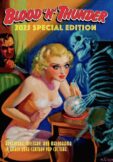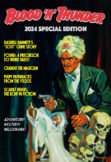EDitorial Comments
Throwback Thursday: H. Bedford-Jones and THE WILDERNESS TRAIL
Exactly 100 years ago today, a fiction reader scanning the magazine rack at his local newsstand might very well have seen the February 1915 issue of Blue Book, one of the classic pulps. That particular issue was an important one, because it contained the debut story of a contributor whose name would become synonymous with the magazine’s title.
Today’s pulp-fiction devotees, born during the Baby Boom years (1946 to 1964), are too young to have bought rough-paper magazines on the newsstands and therefore gravitate primarily to those characters whose life spans were extended by Sixties paperback reprints and frequent appearances in other media: Conan, Tarzan, Doc Savage, The Shadow, and so on. Lester Dent, Walter B. Gibson, and Robert E. Howard are lionized in the fan press, and justifiably so. But they were not pioneers; they trod paths already well worn by the generation of pulpateers that preceded them. And of those, one loomed larger than most of his contemporaries.
Born in 1887, Henry James O’Brien Bedford-Jones spent his early months in Ontario, Canada, the family moving to Michigan when he was barely a year old. The future fictioneer showed an aptitude for writing as a public-school student, and he matriculated at Toronto’s Trinity College but dropped out after one year to pursue a career in journalism. As H. Bedford-Jones, he contributed to newspapers in Detroit and Chicago before turning his hand to fiction. His earliest short stories appeared in Frank A. Munsey’s pioneering pulp magazine, The Argosy, during 1909. He was not quite 22 years old when editor Matthew White purchased them. Published under the pseudonym “H. E. Twinells,” these initial efforts revealed him to be a born storyteller, if not a literary wunderkind.
Over the next few years Bedford-Jones threw himself headlong into full-time fiction writing, placing additional yarns with The Argosy and its sister pulp, The All-Story (later All-Story Weekly), as well as Street & Smith’s People’s Magazine, Top-Notch Magazine, and New Story Magazine. In a 1914 Argosy two-parter, “The Gate of Farewell,” he created what would become his most popular recurring character: John Solomon, the outwardly amiable, innocuous-looking Cockney who was actually a capable covert operative of the British government.
Of Bedford-Jones’ early output his biographer Peter Ruber had this to say: “His writing style during those years was remarkably fluid and polished; his imaginative storytelling ability far superior to many of his contemporaries, and a significant number of those stories are not as dated, nor the dialogue as stilted, as might be expected.”
Late in 1914 Bedford-Jones submitted a book-length novel to The Blue Book Magazine, an up-and-coming sheet published by Louis Eckstein’s Story-Press Corporation. Edited by Ray Long with the assistance of young Donald Kennicott, Blue Book was finally hitting its stride after several years of relative mediocrity. Long purchased the yarn from Bedford-Jones, beginning the author’s decades-long relationship with the magazine that would become his most reliable market. A rousing adventure set in early 19th-century America, The Wilderness Trail saw print in the February 1915 issue alongside tales by such popular fictioneers as H. Rider Haggard, E. Phillips Oppenheim, Ellis Parker Butler, and Albert Payson Terhune.
Over the next 34 years H. Bedford-Jones sold Blue Book an astounding 360 stories, including another five complete-in-one-issue novels and seven serialized novels. He was prolific in every genre but seemed to have a special affinity for historical adventures. Although he had no trouble selling to Long’s successor, Karl Harriman, it was Blue Book’s next editor, Donald Kennicott, who bought the most Bedford-Jones stories—some 280, of all lengths, between 1935 and 1949.
Having gone through a rough patch in the early years of the Depression (the inevitable consequence of failing magazines and reduced word rates), H. Bedford-Jones evolved the strategy of pitching editors not just individual yarns but entire series of stories with a central theme. In 1934 he simultaneously persuaded Kennicott and Short Stories head honcho Harry Maule to let him adopt this approach to the mass production of pulp fiction.
Blue Book’s February 1935 number offered the first installment of “Arms and Men,” a historical series that extended to 28 entries. Bedford-Jones followed this in 1937 with two more skeins, the self-explanatory “Ships and Men” and 17 Foreign Legion adventures collectively titled “Warriors in Exile.” In 1938 he launched what is arguably his best-remembered series for Blue Book. “Trumpets to Oblivion” combined fantasy, science fiction, and historical adventure. The premise involved a wealthy inventor’s perfection of a combination time machine and TV set—a device that reached back into the ether and retrieved images from past history. Each series installment opened with the inventor welcoming an audience to monitor the repeat “broadcast” of some famous event.
Bedford-Jones wrote 19 series for Blue Book, some of them overlapping, and until he died in 1949 each issue contained at least one and often two installments. They were published under his own name and also as by “Gordon Keyne” and “Captain Michael Gallister.” He occasionally turned out novel-lengthers for Kennicott as well, the most memorable of these being They Lived by the Sword, a fictional account of Hannibal’s army crossing the Alps. Remarkably, in addition to pounding out his Blue Book work, Bedford-Jones still found time to contribute regularly to other pulps, placing thematically linked series in Weird Tales and Short Stories as well.
An obituary published in the New York Herald-Tribune stated that H. Bedford-Jones earned more than a million dollars during his 40 years as a fiction writer. In King of the Pulps: The Life and Writings of H. Bedford-Jones (Ontario: The Battered Silicon Dispatch Box, 2003), Peter Ruber estimated that the veteran pulpateer wrote a minimum of 25 million words. The true total may never be known, as Ruber allows that some yarns could have appeared under pseudonyms not yet attributed to the legendarily prolific author.
The Wilderness Trail is a seminal work in Bedford-Jones’ oeuvre. It not only kicked off his 34-year association with Blue Book but also was his first historical novel with an American setting. The author had a deep and abiding interest in the country’s post-Revolutionary War expansion and returned many times to the milieu he describes so well in this yarn. His employment of such real-life characters as Daniel Boone, Zachary Taylor, John J. Audubon, and the Indian chief Tecumseh is particularly skillful; we have no way of knowing if these historical figures ever interacted, but Bedford-Jones weaves the tale so cleverly that it’s easy to believe they did.
The novel is ambitious but never unwieldy. Its plot is straightforward, and seemingly random or divergent events are shown in the concluding chapters to have a critical bearing on the adventure’s climax. The story’s only failing—a minor one—is the awkwardness of romantic interludes featuring hero and heroine. The dialogue in these passages is stilted, which is surprising inasmuch as the exchanges between male characters have a natural ring.
Despite having been written relatively early in the author’s career, Wilderness Trail is a smooth, polished work with the unimpeded narrative drive that was a hallmark not only of H. Bedford-Jones, but of all popular and successful pulp fictioneers. Strangely, no American firm published it in book form, although the London-based firm of Hurst & Blackett Limited issued a British hardcover edition in 1925. Murania Press is both happy and honored to present to American readers this fine example of early pulp fiction, available in this country for the first time in nearly a hundred years. Why not take a chance on it? You can order it right here.
Recent Posts
- Windy City Film Program: Day Two
- Windy City Pulp Show: Film Program
- Now Available: When Dracula Met Frankenstein
- Collectibles Section Update
- Mark Halegua (1953-2020), R.I.P.
Archives
- March 2023
- July 2021
- May 2021
- March 2020
- February 2020
- December 2019
- November 2019
- October 2019
- September 2019
- August 2019
- May 2019
- April 2019
- March 2019
- February 2019
- December 2018
- November 2018
- October 2018
- August 2018
- June 2018
- February 2018
- December 2017
- October 2017
- September 2017
- August 2017
- May 2017
- April 2017
- February 2017
- September 2016
- August 2016
- July 2016
- June 2016
- November 2015
- October 2015
- September 2015
- August 2015
- July 2015
- June 2015
- May 2015
- April 2015
- March 2015
- February 2015
- January 2015
- August 2014
- July 2014
- June 2014
- May 2014
- April 2014
- January 2014
- December 2013
- September 2013
- August 2013
- July 2013
- June 2013
- May 2013
- April 2013
- March 2013
- February 2013
- January 2013
- December 2012
- October 2012
- September 2012
- August 2012
- July 2012
- June 2012
- May 2012
Categories
- Birthday
- Blood 'n' Thunder
- Blood 'n' Thunder Presents
- Classic Pulp Reprints
- Collectibles For Sale
- Conventions
- Dime Novels
- Film Program
- Forgotten Classics of Pulp Fiction
- Movies
- Murania Press
- Pulp People
- PulpFest
- Pulps
- Reading Room
- Recently Read
- Serials
- Special Events
- Special Sale
- The Johnston McCulley Collection
- Uncategorized
- Upcoming Books
- Western Movies
- Windy City pulp convention
Dealers
Events
Publishers
Resources
- Coming Attractions
- Field Guide to Wild American Pulp Artists
- MagazineArt.Org
- Mystery*File
- ThePulp.Net






